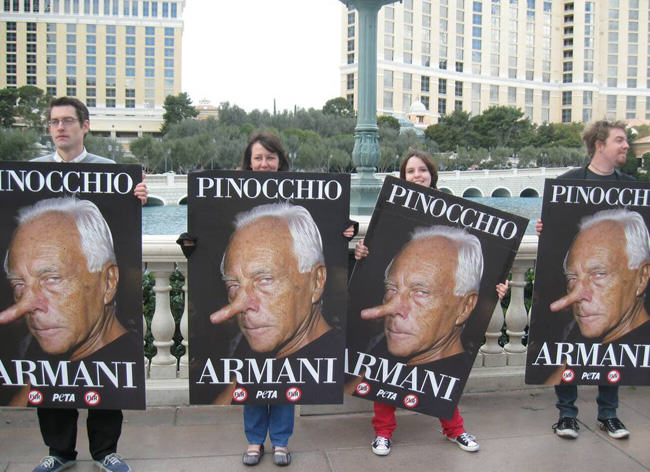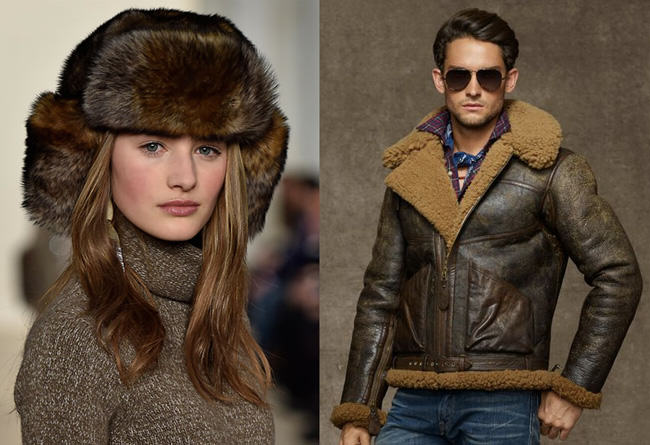
Fashion house Giorgio Armani announced this March it will no longer be using any fur in its products because, in the words of its patriarch and namesake, “Technological progress … allows us to have valid alternatives at our disposition that render the use of cruel practices unnecessary as regards animals.” While this tortuous explanation may sound sincere, it’s not. It’s PR bunkum. So why is Giorgio Armani really ditching fur?
OK, first I need to explain why Giorgio Armani’s statement is bunkum – and add a general disclaimer that I don’t actually know what went down here!
Giorgio Armani’s statement is bunkum because he almost certainly never said it, or even thought it, or had a hand in picking the words. It’s just part of a script prepared by his animal rights handlers.
How can I be so sure? Let’s start with some context.
• Fashion designers don’t use fur for years and then quit of their own volition. There’s always pressure involved from animal rightists.
• Like all fashion houses that use fur, Giorgio Armani has been harassed by animal rightists for years, but unlike some, has shown stiff resistance. Even now, its commitment to quit fur may not mean anything. In 2007, Giorgio told the press, “I spoke with the people from PETA and they showed me some materials that convinced me not to use fur.” But a year later he was back with a collection of fur coats for babies! PETA responded with a poster campaign of Giorgio with a Pinocchio nose and has been gunning for him ever since.
• Giorgio Armani is a huge name in everything from ready-to-wear to haute couture, but in the world of fur is barely a player anymore. For the past several years, rabbit trim has been its thing. So quitting fur will hardly impact its collections. Add to this the fact that two major markets that have buoyed fur’s revival this century are now in the doldrums (Russia) or slowing down (China), and we can say that quitting fur will have a negligible impact on Armani’s profits.
Make This Problem Go Away
Against this backdrop, we can perhaps understand the real reason Giorgio Armani is ditching fur.
As Keith Kaplan of the Fur Information Council of America explained to WWD, when designers are harassed by animal rightists, “I think they consider whether it is worth the threat of store protests and disruption of business and so forth. Right now, because of the economic conditions in Russia and China, I think designers are evaluating and saying, ‘Perhaps at this juncture, it might not be. We’ll give in at this point to make this problem go away’.”
And that, in a nutshell, is probably it. Giorgio Armani just wants to get the animal rights lobby off its back, at a time when the business is already tough enough.
The deal would follow what is now a standard template. The animal rights groups pen a statement to be issued in the name of the designer, claiming he has “seen the light” and will be going fur-free. The animal rightists then trumpet victory, claim full credit for their powers of persuasion, and promise to stop picketing stores and generally making the designer’s life miserable.
In the case of Giorgio Armani, its decision to cave was announced by HSUS and the Fur Free Alliance, “a coalition of 40 animal protection organizations in 28 countries that are trying to end the fur trade”. “Pursuing the positive process undertaken long ago,” Giorgio’s prepared script said, “my company is now taking a major step ahead, reflecting our attention to the critical issues of protecting and caring for the environment and animals.”
Had Giorgio spoken his mind, he might have said, “After years of relentless pressure, I have decided to throw in the towel and give the animal rights nuts what they want because they’re a pain in the butt and I just want them to go away!”
100% Fur-Free?
Meanwhile, inquiring minds are still asking two questions: Is the “100% fur-free” clause in effect? And was any hidden pressure brought to bear on Giorgio Armani?
The “100% fur-free” clause is an unspoken compromise between animal rightists and designers used in closing a tough negotiation. In essence, it is agreed that the animal rightists will praise the designer for abandoning fur completely – going 100% fur-free. Meanwhile, the designer quietly continues to use fur that is a by-product of food production.
Luxury goods manufacturer Hugo Boss recently reached such a deal. In its 2014 Sustainability Report, it explained that it had been “in dialog with several animal and consumer protection organizations for many years, for example with People for the Ethical Treatment of Animals.” Presumably because of these “many years” of harassment (sorry, dialog), it announced that from 2016, it would be restricting the sources used for its fur supplies. Specifically, it would be “concentrating on furs that are byproducts of the food industry,” while halting use of pelts from “raccoon dogs, foxes or rex rabbits”. No mention was made of quitting fur, or even of reducing overall fur use.
HSUS and the Fur Free Alliance then announced that Boss was going “100 percent fur-free”, a false claim that has been repeated widely, including in WWD.
SEE ALSO: IS NO FUR THE RIGHT MOVE FOR HUGO BOSS?
You might think Hugo Boss will get hauled over the coals the next time it trots out a collection of shearling (sheep fur), but it won’t. Ralph Lauren, which uses an enormous amount of shearling, proves that.
FAST FACT: What is shearling? We all know that sheared beaver is the hide and hair of beaver that has been sheared to a short pile to make it lighter and less bulky, and give it a plush feel. Sheared mink is the same deal. When the hide and hair of sheep are used, it is known as shearling. All are types of FUR.
Ralph Lauren’s deal with PETA, on the face of it at least, is the most shameless piece of self-serving, mutual ass-kissing in the history of the fur trade’s relationship with animal rightists. A footnote in the show notes for Ralph Lauren’s fall 2015 collection says it all: “Ralph Lauren has a long-standing commitment to not use fur products in our apparel and accessories. All fur-like pieces featured in the collection are constructed of shearling.”

So Ralph Lauren is now “100% fur-free”, and proudly compliant with “PETA guidelines” since 2006. And PETA loves Ralph Lauren right back. All Ralph Lauren has to do is stick to shearling (tons of it), while both parties insult our intelligence by pretending shearling is not fur.
Hidden Pressure?
Last but not least, we inevitably ask ourselves whether animal rightists finally found Giorgio’s Achilles’ heel. It’s a reasonable question when we consider how long he held out. Maybe he really did fold because fur is not important to the company, or because the luxury fur market is slowing. Or maybe he was made an offer he couldn’t refuse!
Yes, it’s pure speculation, but that was the buzz when Hugo Boss made its deal. No one put it in print, or spoke it on the air waves, but people were thinking it. Could Hugo Boss have been threatened with a campaign telling the world how it got its big break?

Hugo Ferdinand Boss: Nazi Party member, sponsoring member of the SS, and admirer of Hitler. It’s not much of a résumé, is it? This is the man whose company took off as an official supplier of uniforms to branches of the Nazi Party, including the Brownshirts, the SS and the Hitler Youth, using POW’s and forced labourers.
Animal rights groups know all this stuff, of course, and probably have a bunch of other cards up their sleeves just waiting to be played. And maybe they had the dirt on Armani too – we’ll never know.
But one thing is for sure: Giorgio Armani did not quit fur because “Technological progress … allows us to have valid alternatives at our disposition that render the use of cruel practices unnecessary as regards animals”! As readers of Truth About Fur know, and hopefully Giorgio Armani too, technological progress – and a strong commitment by the industry – now allow us to produce beautiful furs without animal suffering.











Does it really matter if Armani is not really heartfelt about giving up fur in his collection? Ok, so he’s responding to pressure brought about by the Animal Rightests. Good enough. And it shows their activism can be effective. Good for them. More power to them.
Point taken. But in an ideal world, views are changed through reasoned debate, not pressure tactics. What is particularly irksome about cases like Armani is that animal rightists claim their targets have “seen the light” and changed of their own accord. It would at least be intellectually honest if they said such and such a company ditched fur because we forced them to.
Kad – saying something intelligent might be more interesting than simply regurgitating pro-fur sentiments. At least it would give others something to actually talk about. I do, however, find it rather amusing that one of your only arguments is fuelled by money.. it says quite a lot about you. Rather than eating pro-fur propaganda, do some proper research and educate yourself.
I don’t know why everyone gives these vegan AR lunatics, who compromise a TINY portion of people and have no real money to spend, any credence. Especially when they can look up the facts for themselves and realize that animals are NOT ever skinned alive unless by AR activists and fur is NOT cruel.